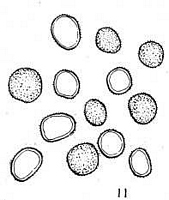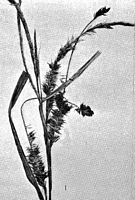|
 Farysia nigra Farysia nigra
SynonymsElateromyces niger
BiostatusPresent in region - Indigenous. Endemic
Images (click to enlarge)
Caption: TEXT-FIG. 28. Elateromyces niger G. H. Cunn. Spores producing conidia, probasidia
being absent. x 1,000. |  | 
Caption: Plate 44, Fig. 1. Elateromyces niger G.H. Cunn. on Carex dipsacea Berrgr. Reduced to
4/9. |
Article: Cunningham, G.H. (1926). Third supplement to the Uredinaceae and Ustilaginaceae of New Zealand. Transactions and Proceedings of the New Zealand Institute 56: 74-80 Wellington:.
Notes: In a former paper on the Ustilaginaceae of New Zealand (Trans. N.Z. Inst., vol. 55, p. 414,
1924) the name Elateromyces Bubak was used for a genus characterized by the presence of
"elaters" in the sori. I find that the name Farysia was used by Raciborski for a species (F.
javanica Racib.) possessing this same character, and, as Raciborski's name has priority, the
three species included in Elateromyces should be cited as under FARYSIA Raciborski,
Bull. Acad. Sci. Cracovic, p. 354, 1906.
F. nigra n. comb.
Syn. Elateromyces niger G. H. Cunn.
Article: Cunningham, G.H. (1924). The Ustilagineae, or "smuts", of New Zealand. Transactions and Proceedings of the New Zealand Institute 55: 397-433 Wellington:.
Description: Sori in occasional ovarieg, at first compact and partially concealed within the perigynium,
becoming exposed when semi-pulverulent, black, elliptical, and up to 6 mm. in length;
intermixed with very numerous conspicuous elaters, black in mass, blackish-olive
individually, which may attain a length of 15 mm. but are commonly less, averaging 10 mm.
Spores globose to shortly elliptical, 6-9 X 5-7 mmm.; epispore minutely and moderately
verruculose, dark olive, 0-75 mmm. thick.
Notes: The host is an endemic species, occurring throughout the lowland areas of both Islands
(Cheeseman, 1906, p. 822).
This is separated from the following species on account of the smaller and more regular
spores, black colour of the sori, elaters, and spores, and the conspicuous elaters. These latter
are so numerous as to give the sori a woolly appearance, as;if a small tuft of hair had been
caught and held in the position occupied by the sorus.
Germination.- In water, after three days, a few spores germinated after the material had been
kept in the herbarium for twenty-one months. The method of germination is similar to E.
olivaceus, a small probasidium being produced. . This is elliptical in shape, and about the
same length as the spore. Shortly after its formation it becomes detached and functions as a
conidium. The spores did not germinate when placed in nutrient solution (soil extract).
|